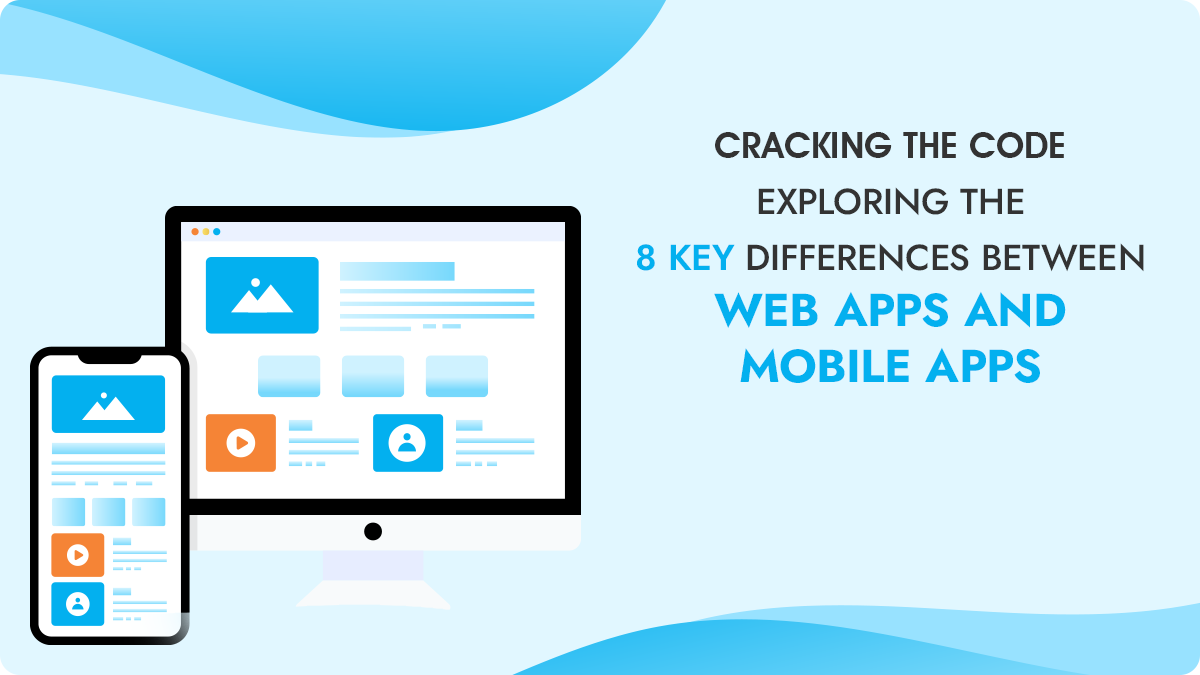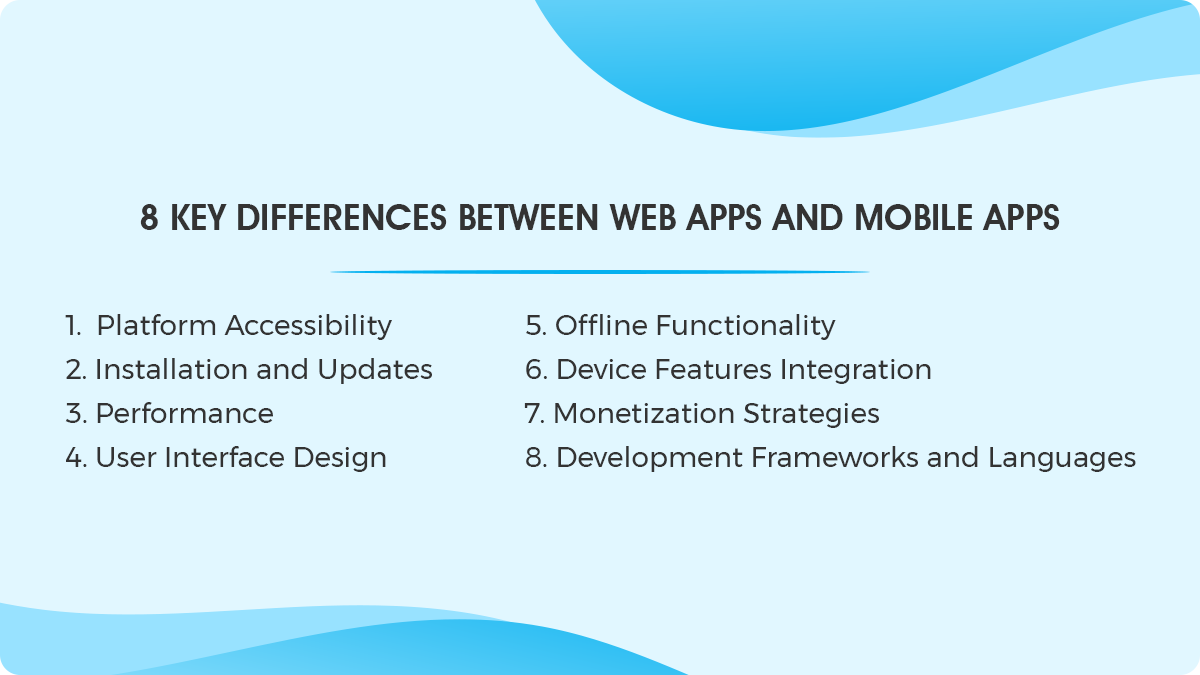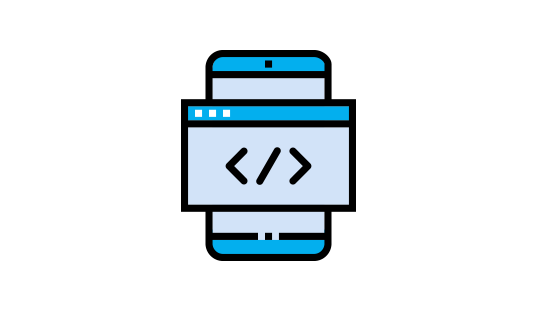In the fast-paced digital era, the development of applications has become an integral part of modern business strategies. Whether you’re a seasoned developer or a business owner seeking an online presence, understanding the differences between web apps and mobile apps is crucial for making informed decisions. In this comprehensive exploration, we’ll delve into the eight key distinctions that set these two types of applications apart.
Let’s begin by understanding the basic definitions of mobile apps and web apps:

Mobile App:
A mobile app, short for mobile application, is a software application specifically designed to run on mobile devices such as smartphones and tablets. These applications are developed for specific platforms, such as iOS for Apple devices and Android for a wide range of smartphones. Mobile apps are typically downloaded and installed from app stores, providing users with a dedicated interface and direct access to the device’s features.
Key Characteristics:
- Platform Specific: Mobile apps are often developed for a specific mobile operating system (iOS, Android, etc.).
- Installation: Users need to download and install mobile apps from app stores.
- Optimized for Devices: Mobile apps are optimized for touchscreens and the unique features of mobile devices.
- Offline Functionality: Many mobile apps can function offline, providing certain features even without an internet connection.
Web App:
A web app, short for web application, is a software application accessed and interacted with through a web browser. Unlike mobile apps, web apps are not installed on the user’s device but are hosted on remote servers and accessed via the internet. Users can access web apps through URLs using a browser, and they typically work across various devices, irrespective of the operating system.
Key Characteristics:
- Platform Independent: Web apps are accessible through web browsers, making them platform independent.
- No Installation Required: Users do not need to download or install web apps; they can access them directly through a browser.
- Responsive Design: Web apps are designed to be responsive, adapting to different screen sizes and orientations.
- Requires Internet Connection: Most web apps require an internet connection to function, although technologies like Progressive Web Apps (PWAs) provide some offline capabilities.
Read more: How Can a Mobile App Development Company Attract Customers? (In 2023)
Key Differences Between Mobile & Web Apps:

1. Platform Accessibility:
Web Apps: Web applications are designed to run in a web browser and are accessible on any device with an internet connection. This universality makes them platform-independent and adaptable to various screen sizes.
Mobile Apps: Mobile applications, on the other hand, are specifically crafted for mobile devices. They are downloaded and installed from app stores, offering optimized performance for smartphones and tablets. Mobile apps often leverage native features of the device, providing a tailored user experience.
2. Development Frameworks:
Web Apps: Web app development relies on technologies such as HTML, CSS, and JavaScript. Developers use frameworks like React, Angular, or Vue.js to create dynamic and interactive user interfaces.
Mobile Apps: Mobile app development involves different frameworks based on the platform. For iOS, developers use Swift or Objective-C, while Android apps are typically written in Java or Kotlin. Cross-platform frameworks like Flutter or React Native have gained popularity, allowing developers to write code that works on both major platforms.
3. User Interface Design
Web Apps: Web app UI is designed to be responsive, adjusting to different screen sizes and orientations. Responsive web design ensures a consistent user experience across devices.
Mobile Apps: Mobile app UI is tailored for touch interactions, making use of gestures like swiping, tapping, and pinching. Native mobile apps adhere to platform-specific design guidelines (Material Design for Android, Human Interface Guidelines for iOS) to provide a familiar and intuitive experience.
4. Offline Functionality:
Web Apps: Web apps generally require an internet connection to function fully. While technologies like Progressive Web Apps (PWAs) enable offline capabilities, the experience might be limited compared to native mobile apps.
Mobile Apps: Mobile apps can be designed to work seamlessly offline, allowing users to access certain features or content without an internet connection. This is particularly advantageous in areas with limited connectivity.
5. Installation and Updates:
Web Apps: Web apps are accessible through URLs and do not need installation. Users can access them instantly by entering the web address into a browser.
Mobile Apps: Mobile apps are distributed through app stores (Google Play for Android, App Store for iOS). Users download and install them on their devices, providing a dedicated space for the app.
Read more: How To Hire Mobile App Developers: A Detailed Guide for 2023
6. Updates:
Web Apps: Web apps are updated automatically when users access the latest version through the browser. Developers have immediate control over updates.
Mobile Apps: Updates for mobile apps need to go through app store approval processes. Users must manually download and install updates, which might lead to fragmentation if users are slow to update.
7. Performance:
Web Apps: Web apps might face performance challenges, especially on slower internet connections. While advancements like WebAssembly enhance performance, native apps often outperform web apps in terms of speed and responsiveness.
Mobile Apps: Mobile apps are optimized for specific devices, resulting in superior performance. They have direct access to device features, enabling smoother animations and faster response times.
8. Device Features Integration:
Web Apps: Web apps have limited access to device features. While APIs like geolocation and camera access exist, they might not offer the same depth of integration as mobile apps.
Mobile Apps: Mobile apps can fully leverage device features such as GPS, camera, accelerometer, and push notifications. This integration enhances user experience and enables functionalities unique to each platform.
Conclusion:
Cracking the code between web apps and mobile apps involves a nuanced understanding of their unique characteristics. Web apps provide versatility and accessibility, making them suitable for a broad audience. Mobile apps, however, offer a more tailored experience, capitalizing on the specific features of mobile devices.
Choosing between web and mobile development depends on factors like target audience, functionality, and development resources. In some cases, businesses opt for a hybrid approach, developing both web and mobile applications to cater to diverse user preferences.
As technology continues to evolve, the boundaries between web and mobile development are becoming more fluid. New frameworks and technologies emerge, aiming to bridge the gap and provide seamless experiences across platforms. Regardless of the choice, staying informed about these key differences is paramount for successful application development in the ever-evolving digital landscape.
Since 2011, Universal Stream Solution has led the web apps and mobile app development revolution as the finest provider of web and mobile app development services.
We provide our clients throughout the world with the best web development services. To provide top-notch web development services, we have a talented staff of knowledgeable web developers who stay on top of the latest developments. If you want to embrace these trends, get in touch with our experts right away.
